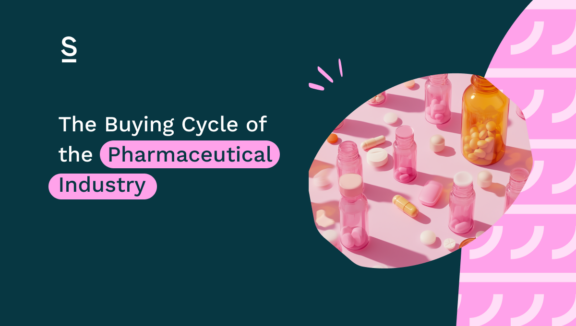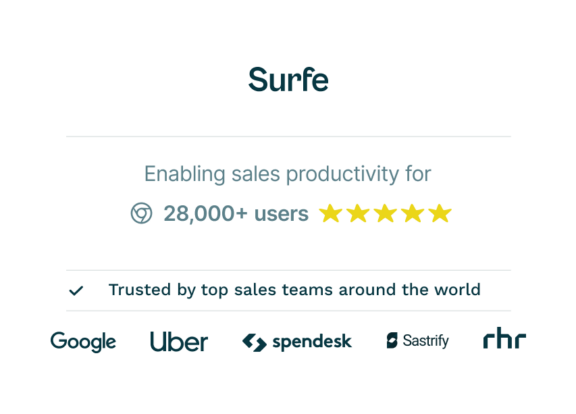The Buying Cycle of the Pharmaceutical Industry

The pharmaceutical industry is fast-moving, with complex regulation changes and new medical recommendations affecting how c-suite executives run their businesses. For sales professionals, understanding the journey these business leaders go through to buy their products and services is essential to close more deals. We call this journey the buying cycle; it’s a series of stages that executives move through before making a purchase decision, and in the pharmaceutical industry it can be difficult to track.
Factors like regulatory demands, the need for innovative solutions, and the involvement of multiple stakeholders, mean that sales teams operating in this space need to know exactly when to time outreach campaigns that will really convert.
Ready to find out how? In this article, we’ll cover:
What Is the Buying Cycle?
The buying cycle refers to the process that a buyer goes through when deciding whether to purchase a product or service. This cycle is particularly important when selling to top executives in the pharmaceutical industry because these buying decisions are often high-stakes, involving substantial investments and impacting long-term business strategies. Understanding the buying cycle will help you anticipate the needs of your prospects, so you can tailor your messaging, and guide executives smoothly through the decision-making process.
In the pharmaceutical industry, the buying cycle is often extended due to the sector’s inherent complexities. For instance, regulatory compliance requirements, the need for detailed data and research, and the involvement of multiple stakeholders all contribute to a more drawn-out and structured buying process. Executives are not only concerned with the immediate benefits of a product or service but also with its long-term implications, both from a regulatory and a financial perspective.
Stages of the Buying Cycle
- Awareness Stage
The buying journey begins when an executive becomes aware of a need or problem. In the pharmaceutical industry, this could be recognizing the need for a new drug delivery system, a more efficient R&D process, or a solution that ensures compliance with evolving regulations.
Let’s take this as an example: consider a pharmaceutical company’s CEO who realizes that their current data management system is outdated and not equipped to handle the upcoming compliance changes. This awareness triggers the start of the buying cycle.
2. Consideration Stage
During this stage, the executive begins exploring potential solutions. This is when they start seeking out information, engaging with content, and considering different options.
The CEO, now aware of the need for a better data management system, might start researching various platforms that offer enhanced compliance tracking and data security. They might engage with content such as white papers or case studies to understand the available solutions better.
3. Evaluation Stage
Here, the executive evaluates different options and vendors. They are looking for the best fit in terms of features, ROI, and alignment with their company’s goals.
The CEO narrows down the list of potential data management platforms and begins scheduling demos, speaking with sales representatives, and analyzing ROI projections. This stage is critical as it determines which vendor will move forward to the decision stage.
4. Decision Stage
In this stage, the executive makes the final purchasing decision. This often involves final negotiations, aligning all stakeholders, and securing the necessary approvals.
After evaluating the options, the CEO decides on a data management platform that offers the best balance between cost, functionality, and compliance support. Final discussions are held to negotiate terms, and once all stakeholders are in agreement, the purchase is made.
5. Post-Purchase Stage
The buying cycle doesn’t end with the purchase. The post-purchase stage involves reviewing the decision, implementing the product or service, and assessing its impact.
After implementing the new data management platform, the CEO conducts a review to ensure it meets all expectations. This stage is crucial for building long-term relationships and identifying opportunities for future upselling or cross-selling.
Identifying the Stages of the Buying Cycle
Recognizing where an executive is in the buying cycle requires keen observation and analysis of various signals. These signals can come from direct conversations, engagement with content, and buyer intent data.
- Conversations: Pay attention to the questions and concerns raised by the executive. For instance, if they are asking general questions about industry trends, they are likely in the Awareness stage. If they are inquiring about specific product features, they may be in the Evaluation stage.
- Content Engagement: Monitoring how an executive interacts with your content can provide valuable insights. For example, if they are frequently downloading white papers or attending webinars, they might be in the Consideration stage.
- Buyer Intent Data: Tools that track buyer intent data can help you understand what an executive is researching online and how their behavior is evolving. This data is invaluable for pinpointing the exact stage of the buying cycle.
How Your Tech Stack Can Help You Identify Buying Stages
- CRM Systems: Customer Relationship Management (CRM) systems are essential for tracking interactions with executives and mapping out their journey through the buying cycle. CRM systems can log every touchpoint, from initial contact to post-purchase follow-ups.
- Buyer Intent Data: Platforms that offer buyer intent data can help you understand what topics are currently of interest to the executive. For example, if they are reading a lot about regulatory compliance, this might indicate they are moving into the Consideration or Evaluation stages.
- Analytics Tools: Use analytics tools to monitor how executives are engaging with your content. This data can help you identify patterns and predict when an executive is likely to move from one stage to the next.
- Account-Based Marketing (ABM): ABM allows you to tailor your approach to specific accounts, providing personalized content and communication that aligns with the executive’s stage in the buying cycle. This strategy is particularly effective in the pharmaceutical industry, where decision-makers often require highly customized solutions.
Aligning Your Strategy with Each Stage
Awareness Stage: Generating Interest and Establishing Credibility
In the Awareness stage, your goal is to generate interest and establish credibility. This can be achieved through thought leadership content and social selling.
- Thought Leadership: Develop and share content that highlights industry challenges and emerging trends. For example, a blog post discussing the latest FDA regulations and their impact on pharmaceutical companies could attract the attention of top executives.
- Social Selling: Utilize platforms like LinkedIn to share valuable insights and connect with executives. Engage with their posts, join relevant industry groups, and position yourself as a knowledgeable resource.
Consideration Stage: Positioning Your Solution as a Viable Option
Once an executive reaches the Consideration stage, your focus should shift to positioning your solution as a viable option.
- Case Studies and White Papers: Provide detailed case studies that show how your solution has helped similar companies in the pharmaceutical industry. White papers that delve into the technical aspects of your product can also be effective.
- Direct Communication: Engage in direct communication through webinars or one-on-one meetings. This allows you to address specific concerns and demonstrate how your solution meets their needs.
Evaluation Stage: Differentiating Your Solution from Competitors
During the Evaluation stage, your primary goal is to differentiate your solution from competitors.
- Tailored Demos: Offer demos that are customized to the executive’s specific requirements. For example, show how your data management system can streamline compliance processes unique to their organization.
- ROI Analysis: Provide a detailed ROI analysis that highlights the financial benefits of your solution. Executives in the pharmaceutical industry are particularly focused on cost-effectiveness and long-term value.
- Testimonials: Share testimonials from other pharmaceutical companies that have successfully implemented your solution. Real-world examples can significantly influence the executive’s decision.
Decision Stage: Facilitating a Smooth Decision-Making Process
In the Decision stage, your objective is to facilitate a smooth decision-making process.
- Transparent Pricing: Offer clear and transparent pricing and contract terms. Avoid hidden fees or complex legal jargon that could create friction.
- Alignment with Stakeholders: Ensure that all decision-makers are aligned. This might involve coordinating with other departments within the executive’s company to address any last-minute concerns.
Post-Purchase Stage: Ensuring Satisfaction and Building Long-Term Relationships
The Post-Purchase stage is about ensuring satisfaction and laying the groundwork for long-term relationships.
- Onboarding Support: Provide comprehensive onboarding support to help the executive’s team fully understand and utilize the product or service. This could include training sessions, user manuals, and ongoing support.
- Follow-Ups: Conduct regular follow-ups to gather feedback and identify opportunities for upselling or cross-selling. For example, if the executive is satisfied with your data management system, they might be interested in additional modules or complementary services.
Common Challenges and How to Overcome Them
Extended Buying Cycles
The pharmaceutical industry is known for its extended buying cycles. This can be challenging for sales professionals. Patience and persistence are the keys to maintaining momentum behind the sale.
Regularly check in with the executive, providing updates on industry developments and new features of your solution. This keeps the conversation active and maintains their interest.
Multiple Decision-Makers
Navigating an organization with multiple stakeholders can be complex. Each decision-maker may have different priorities and concerns.
Engage with all relevant parties early in the process. Use ABM strategies to tailor your communication to the needs of each stakeholder, ensuring that everyone is on board with the proposed solution.
Regulatory and Compliance Considerations
Regulatory requirements can significantly impact the buying cycle in the pharmaceutical industry. Executives are often cautious about adopting new solutions due to the potential compliance risks.
Position your solution as compliant and beneficial. Provide detailed documentation that demonstrates how your product meets regulatory standards and helps the company avoid compliance issues.
Adapting to Changing Buying Cycles
Monitoring and Adjusting Your Approach
The buying cycle is not static. External factors, such as economic changes or new regulations, can shift the timeline or priorities of an executive.
Continuously monitor the executive’s progress through the buying cycle and adjust your strategy as needed. Be prepared to pivot if new challenges arise, and maintain flexibility in your approach.
Learn From Firsthand Feedback
Collecting feedback after each stage of the buying cycle is essential for refining your approach and improving future engagements.
Use feedback to better predict and navigate the buying cycles of other executives in the industry. For example, if an executive mentions that they appreciated detailed ROI analysis, make this a standard part of your approach in future sales cycles.
Let’s Wrap It Up!
So, now you know how to map your sales strategy against pharmaceutical executives’ buying cycles. Armed with the knowledge of how to track behavioral signals, you’re ready to get selling and convert more deals. For the best chance of success, remember to stay flexible in your timelines, be on the front foot with regulatory changes, and continuously seek feedback from your customers to refine your approach to landing more prospects.

Want to close more deals with pharma companies?
Use Surfe to find pharmaceutical companies that match your ICP, identify decision makers within those companies, and then fill your CRM automatically with their verified contact details.
Frequently Asked Questions (FAQs)
Why is the buying cycle longer in the pharmaceutical industry?
The buying cycle is longer due to the industry’s complexity, regulatory requirements, and the involvement of multiple stakeholders.
How can I identify which stage an executive is in?
Look for signals such as the questions they ask, their content engagement, and buyer intent data.
What are the key challenges in selling to pharmaceutical executives?
Extended buying cycles, multiple decision-makers, and regulatory considerations are some of the primary challenges.
How can I adapt my sales strategy to changing buying cycles?
Continuously monitor the executive’s progress, adjust your approach as needed, and stay flexible to respond to external factors.


